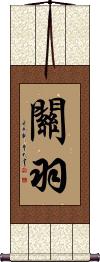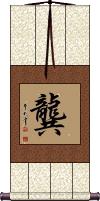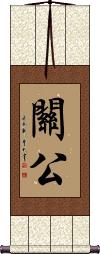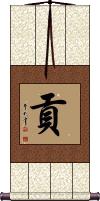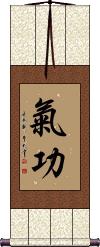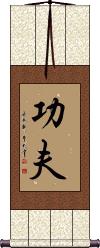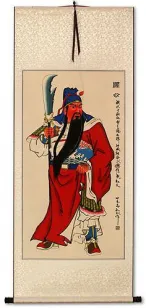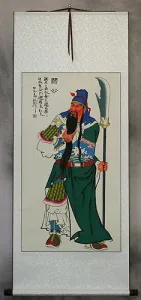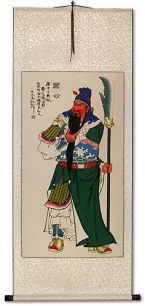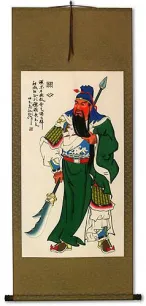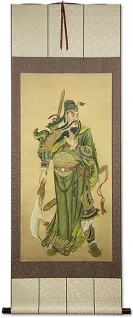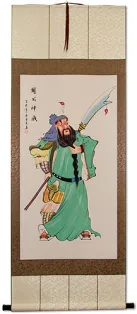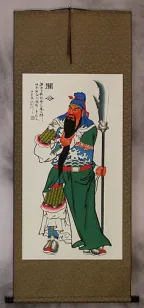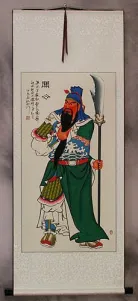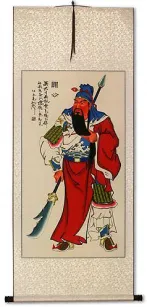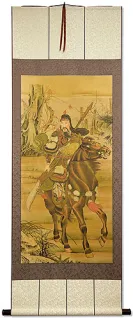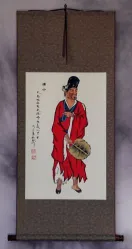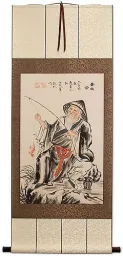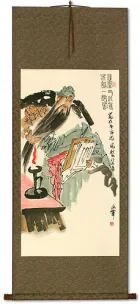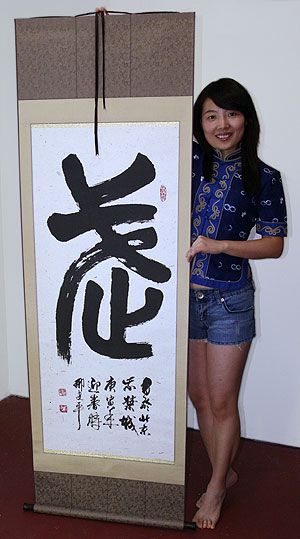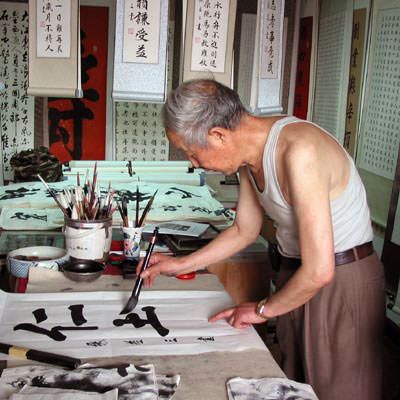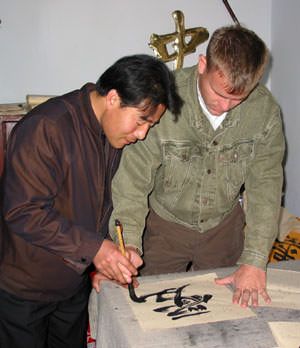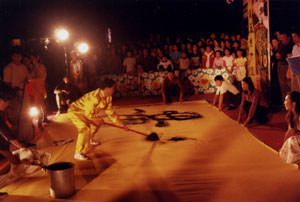Many custom options...
And formats...

Chi Gong in Chinese / Japanese...
Buy a Chi Gong calligraphy wall scroll here!
Personalize your custom “Chi Gong” project by clicking the button next to your favorite “Chi Gong” title below...
1. Guan Yu
2. Kung / Gong
Guan Yu
關羽 is the name Guan Yu, Army General for the Kingdom of Shu.
He is also known as Guan Gong (like saying Duke Guan or Sir Guan)
He was immortalized in the novel, “Romance of the Three Kingdoms.”
He was a fearsome fighter, also famous for his virtue and loyalty. He is worshiped by some modern-day soldiers and has the title “Warrior Saint” in China. Some believe he offers safety and protection for military servicemen.
Guan Yu lived until 219 A.D.
Kung / Gong
龔 is a Chinese surname that can be romanized as Gong or Kung.
From most of China, it would be Gong, but from Cantonese, it is often romanized as Kung.
In Korean, this could be a surname that romanizes as Gong or Kong and is now written as 공.
The original meaning of the character was something like, “to provide.”
Guan Gong / Warrior Saint
關公 is a Chinese title, Guan Gong, that means Lord Guan (The warrior saint of ancient China).
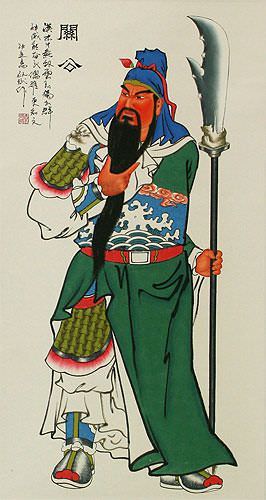 While his real name was Guan Yu / 關羽, he is commonly known by the title of Guan Gong (關公).
While his real name was Guan Yu / 關羽, he is commonly known by the title of Guan Gong (關公).
Some Chinese soldiers still pray to Guan Gong for protection. They would especially do this before going into battle. Statues of Guan Gong are seen throughout China.
Kung / Gong / Mitsugi
Surname
貢 is a Chinese surname that can romanize as Gong from Mandarin or Kung from Cantonese.
In Japan, this can be the surname or given name Mitsugi.
The meaning of this is tribute or gifts.
Qi Gong / Chi Kung
氣功 or Qigong is the title of a technique that is somewhere between medical practice, meditation, and in some cases, religion.
The definition is blurred depending on which school of Qigong you are following. In some cases, it is even incorporated with martial arts.
Some people (even Chinese people) mix this title with Tai Chi (Tai Qi) exercises.
Lately, in China, people will claim to practice Tai Chi rather than Qigong because the Qigong title was recently used as a cover for an illegal pseudo-religious movement in China with the initials F.G. or F.D. (I can not write those names here for fear of our website being banned in China).
You can learn those names and more here: Further info about Qigong
If you are wondering why I wrote “Qi Gong” and “Chi Kung” as the title of this calligraphy entry, I should teach you a little about the various ways in which Chinese can be Romanized. One form writes this as “Chi Kung” or “Chikung” (Taiwan). In the mainland and elsewhere, it is Romanized as “Qi Gong” or “Qigong.” The pronunciation is the same in Taiwan, mainland, and Singapore Mandarin. Neither Romanization is exactly like English. If you want to know how to say this with English rules, it would be something like “Chee Gong” (but the “gong” has a vowel sound like the “O” in “go”).
Romanization is a really confusing topic and has caused many Chinese words to be mispronounced in the west. One example is “Kung Pao Chicken,” which should actually be more like “Gong Bao” with the “O” sounding like “oh” for both characters. Neither the Romanization system in Taiwan nor the Mainland is perfect, in my opinion, and leads to many misunderstandings.
In modern Japan, you may see this written as 気功, but the original 氣功 is still recognized. If you need the Japanese version, please contact me.
Kung Fu / Gong Fu
功夫 or Kung Fu is one of the most famous types of martial arts in the world - and not just because of Bruce Lee.
Some translate the meaning as “Accomplishment by Great Effort.” I think this is partially true, but directly translated, it literally means “Merit/Achievement/Accomplishment Man.” The word “fu” can sometimes mean “husband” or “porter,” but in this case, it can only mean “man.” However, few in China will think “man” when they hear the word “Gong Fu” spoken.
This term is also used for things other than martial arts. In fact, it's used to refer to a person with excellent skills in crafts that require a lot of effort to master, such as cooking, tea ceremonies, and calligraphy.
What a lot of people don't know is that the spelling of “Kung Fu” was actually taken from the old Wade Giles form of Romanization. Using this method, the sounds of the English “G” and “K” were both written as “K” and an apostrophe after the “K” told you it was supposed to sound like a “G.” Nobody in the west knew this rule, so most people pronounce it with a “K-sound.” And so, Gong Fu will always be Kung Fu for most westerners.
Also, just to educate you a little more, the “O” in “Gong” has a sound like the English word “oh.”
The popular Chinese dish “Kung Pao Chicken” suffers from the same problem. It should actually be “Gong Bao Chicken.”
Historical note: Many will claim that Kung Fu was invented by the monks of the Shaolin monastery. This fact is argued in both directions by scholars of Chinese history. Perhaps it is more accurate to say that the Shaolin Monks brought the original fame to Kung Fu many generations ago.
Japanese note: While most Japanese martial artists will recognize these characters, Katakana is more often used to approximate the pronunciation of "Kung Fu" with "カンフー." Some will argue as to whether this should be considered a Japanese word at all.
See Also: Bruce Lee
This in-stock artwork might be what you are looking for, and ships right away...
Gallery Price: $200.00
Your Price: $79.88
Gallery Price: $200.00
Your Price: $79.88
Gallery Price: $200.00
Your Price: $79.88
Gallery Price: $200.00
Your Price: $79.88
Guan Gong Warrior Saint On Horseback
Large Wall Scroll
Discounted Blemished
Gallery Price: $71.00
Your Price: $39.00
Not the results for chi gong that you were looking for?
Below are some entries from our dictionary that may match your chi gong search...
| Characters If shown, 2nd row is Simp. Chinese |
Pronunciation Romanization |
Simple Dictionary Definition |
磬 see styles |
qìng qing4 ch`ing ching kei / ke けい |
More info & calligraphy: Khánhsounding stone; qing; ancient Chinese chime shaped like a chevron (inverted 'v'), orig. of stone, today often metal, in Japan primarily used at Buddhist temples; (given name) Kei A piece of flat stone or metal, used as a gong, or for musical percussion. |
龔 龚 see styles |
gōng gong1 kung kū |
More info & calligraphy: Kung / Gongto provide |
こん see styles |
gon ごん |
(archaism) (feminine speech) (secret language of court ladies) (See 牛蒡) great burdock; (place-name) Gong; Khong; Conn |
コーン see styles |
goon ゴーン |
More info & calligraphy: Coan |
呯 see styles |
píng ping2 p`ing ping |
(onom.) bang! (gong, gun firing etc) |
敲 see styles |
qiāo qiao1 ch`iao chiao noboru のぼる |
to hit; to strike; to tap; to rap; to knock; to rip sb off; to overcharge (given name) Noboru To knock, beat, pound, e.g. a drum, gong, or gate. |
椎 see styles |
zhuī zhui1 chui shii; shii / shi; shi しい; シイ |
(bound form) vertebra (kana only) any beech tree of genus Castanopsis; chinquapin; chinkapin; (female given name) Shiina A hammer, especially for a gong, etc.; idem 槌. |
篩 筛 see styles |
shāi shai1 shai furui ふるい |
(bound form) a sieve; to sieve; to sift; to filter; to eliminate through selection; to warm a pot of rice wine (over a fire or in hot water); to pour (wine or tea); (dialect) to strike (a gong) (1) sieve; sifter; screen; (2) screening (jobs, candidates, etc.) |
鉦 钲 see styles |
zhēng zheng1 cheng kane; shou / kane; sho かね; しょう |
gong used to halt troops gong; handbell; (given name) Masashi A small gong struck during the worship, or service. |
鑼 锣 see styles |
luó luo2 lo |
gong; CL:面[mian4] |
ちん see styles |
chin チン |
jing (Korean gong) (kor:); (place-name) Chin (Burmah); Ching; Chinn; Zinn |
喚鐘 唤钟 see styles |
huàn zhōng huan4 zhong1 huan chung kanshō |
半鐘 (or飯鐘) The dinner bell or gong. |
子貢 子贡 see styles |
zǐ gòng zi3 gong4 tzu kung shikou / shiko しこう |
Zi Gong or Duanmu Ci 端木賜|端木赐[Duan1 mu4 Ci4] (520 BC-), disciple of Confucius (personal name) Shikou |
廝鑼 厮锣 see styles |
sī luó si1 luo2 ssu lo |
small gong |
愚公 see styles |
gukou / guko ぐこう |
(char) Yu Gong (main character in the 4th century BC Chinese fable "The Foolish Old Man Removes the Mountains"); Yúgōng; Yukong; (ch) Yu Gong (main character in the 4th century BC Chinese fable "The Foolish Old Man Removes the Mountains"); Yúgōng; Yukong |
敲鑼 敲锣 see styles |
qiāo luó qiao1 luo2 ch`iao lo chiao lo |
to beat a gong |
曾鞏 曾巩 see styles |
zēng gǒng zeng1 gong3 tseng kung soukyou / sokyo そうきょう |
Zeng Gong (1019–1083), Song dynasty writer, one of the eight giants 唐宋八大家[Tang2-Song4 ba1da4jia1] (personal name) Soukyō |
木鐸 木铎 see styles |
mù duó mu4 duo2 mu to bokutaku ぼくたく |
(1) bell with wooden clapper; (2) leader; guide (of the public) wooden gong |
木魚 木鱼 see styles |
mù yú mu4 yu2 mu yü mokugyo もくぎょ |
mokugyo; wooden fish (percussion instrument) (Buddhist term) fish gong; fish wood block; temple block; round, hollow, wood block (vaguely fish-shaped, usu. with scales), struck while chanting sutras The wooden fish; there are two kinds, one round for use to keep time in chanting, the other long for calling to meals. The origin of the use of a fish is unkজxample to monks to be watchful: there is no evidence of connection with the Christian ίχθύς.ί 木馬 Wooden horse, a symbol of emancipation. |
杢魚 see styles |
mokugyo もくぎょ |
(Buddhist term) fish gong; fish wood block; temple block; round, hollow, wood block (vaguely fish-shaped, usu. with scales), struck while chanting sutras |
犍稚 see styles |
jiān zhì jian1 zhi4 chien chih kenchi |
ghaṇṭā, also 犍地; 犍椎; 犍槌; 犍遲; a bell, gong, or any similar resonant article. |
玄奘 see styles |
xuán zàng xuan2 zang4 hsüan tsang genjou / genjo げんじょう |
Xuanzang (602-664), Tang dynasty Buddhist monk and translator who traveled to India 629-645 (given name) Genjō; (person) Xuanzang (602-664) Xuanzang, whose name is written variously e. g. Hsüan Chuang, Hiüen-tsang, Hiouen Tsang, Yüan Tsang, Yüen Chwang; the famous pilgrim to India, whose surname was 陳 Chen and personal name 禕 Wei; a native of Henan, A. D. 600-664 (Giles). It is said that he entered a monastery at 13 years of age and in 618 with his elder brother, who had preceded him in becoming a monk, went to Chang-an 長安, the capital, where in 622 he was fully ordained. Finding that China possessed only half of the Buddhist classics, he took his staff, bound his feet, and on foot braved the perils of the deserts and mountains of Central Asia. The date of his setting out is uncertain (629 or 627), but the year of his arrival in India is given as 633: after visiting and studying in many parts of India, he returned home, reaching the capital in 645, was received with honour and presented his collection of 657 works, 'besides many images and pictures, and one hundred and fifty relics, 'to the Court. Taizong, the emperor, gave him the 弘福寺 Hongfu monastery in which to work. He presented the manuscript of his famous 大唐西域記 Record of Western Countries in 646 and completed it as it now stands by 648. The emperor Gaozong called him to Court in 653 and gave him the 慈恩寺 Cien monastery in which to work, a monastery which ever after was associated with him; in 657 he removed him to the 玉華宮 Yuhua Gong and made that palace a monastery. He translated seventy-five works in 1335 juan. In India he received the titles of 摩訶耶那提婆 Mahāyānadeva and 木叉提婆 Mokṣadeva; he was also known as 三藏法師 Tripiṭaka teacher of Dharma. He died in 664, in his 65th year. |
珙縣 珙县 see styles |
gǒng xiàn gong3 xian4 kung hsien |
Gong county in Yibin 宜賓|宜宾[Yi2 bin1], Sichuan |
翔公 see styles |
xiáng gōng xiang2 gong1 hsiang kung Shō Kō |
Xiang Gong |
貢嘎 贡嘎 see styles |
gòng gá gong4 ga2 kung ka |
Gonggar county, Tibetan: Gong dkar rdzong, in Lhokha prefecture 山南地區|山南地区[Shan1 nan2 di4 qu1], Tibet |
貢茶 贡茶 see styles |
gòng chá gong4 cha2 kung ch`a kung cha goncha ゴンチャ |
tribute tea; fine quality tea (company) Gong Cha (Taiwanese bubble tea chain); (c) Gong Cha (Taiwanese bubble tea chain) |
輪子 轮子 see styles |
lún zi lun2 zi5 lun tzu wako わこ |
wheel; (derog.) Falun Gong practitioner; CL:個|个[ge4] (1) hourglass-shaped object; (2) sarugaku performance art using such an object; (female given name) Wako |
鉦鼓 钲鼓 see styles |
zhēng gǔ zheng1 gu3 cheng ku shouko; shougo / shoko; shogo しょうこ; しょうご |
(See 雅楽) small gong (used in gagaku) Cymbals, or small gongs and drums. |
銅羅 see styles |
doura / dora どら |
(kana only) gong; tam-tam |
銅鑼 铜锣 see styles |
tóng luó tong2 luo2 t`ung lo tung lo dōra どら |
gong (kana only) gong; tam-tam A gong. |
Click here for more chi gong results from our dictionary
The following table may be helpful for those studying Chinese or Japanese...
| Title | Characters | Romaji (Romanized Japanese) | Various forms of Romanized Chinese | |
| Guan Yu | 關羽 关羽 | guān yǔ / guan1 yu3 / guan yu / guanyu | kuan yü / kuanyü | |
| Kung Gong | 龔 龚 | gōng / gong1 / gong | kung | |
| Guan Gong Warrior Saint | 關公 关公 | guān gōng guan1 gong1 guan gong guangong | kuan kung kuankung |
|
| Kung Gong Mitsugi | 貢 贡 | mitsugi | gòng / gong4 / gong | kung |
| Qi Gong Chi Kung | 氣功 气功 | ki kou / kikou / ki ko | qì gōng / qi4 gong1 / qi gong / qigong | ch`i kung / chikung / chi kung |
| Kung Fu Gong Fu | 功夫 | kan fu / ku fu kanfu / kufu | gōng fu / gong1 fu / gong fu / gongfu | kung fu / kungfu |
| In some entries above you will see that characters have different versions above and below a line. In these cases, the characters above the line are Traditional Chinese, while the ones below are Simplified Chinese. | ||||
Successful Chinese Character and Japanese Kanji calligraphy searches within the last few hours...
